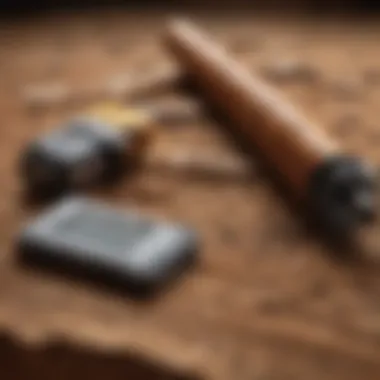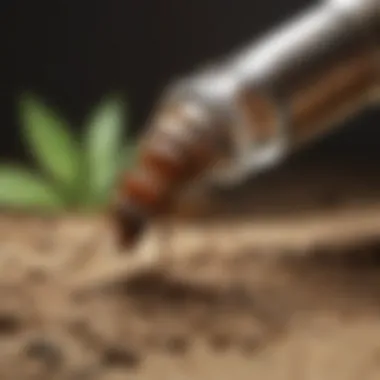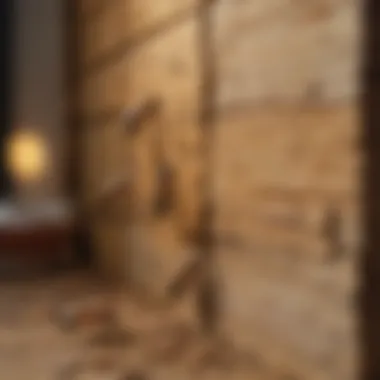DIY Guide: Spot Treating Termites Effectively


Intro
Termites can be a hidden menace in homes, often going unnoticed until significant damage has occurred. Understanding how to manage these pests is crucial for maintaining a safe living environment. Homeowners must be equipped with knowledge about spotting, monitoring, and treating termite infestations. By learning effective treatment methods, you can mitigate the potential harm to your property while saving on professional pest control services. This guide will help you identify the signs of termites, the prevention methods available, and practical DIY treatment solutions.
Pest Identification
Common Household Pests
Identifying the type of pests in your home is the first step in addressing any potential threats. Termites are often confused with other wood-destroying insects such as carpenter ants.
The two main types of termites that may infest homes are:
- Subterranean Termites: These termites live underground and are responsible for most of the damage in homes. They require moisture to survive and create mud tubes for travel.
- Drywood Termites: These termites live within the wood they consume and do not require contact with the soil. They tend to infest furniture or structures.
Signs of Infestation
Recognizing the signs of a termite infestation early can save your property from extensive damage. Some key indicators to look for include:
- Mud Tubes: These are pencil-sized tunnels made up of soil and wood particles. They allow subterranean termites to travel between their nests and the wood they eat.
- Wood Damage: Hollow-sounding wood or wood that crumbles easily when tapped can indicate termite presence.
- Frass: This is termite excrement, resembling small wood shavings, often found near infested areas.
"Timely recognition of termite signs leads to effective interventions, preserving the integrity of your home."
Prevention Methods
Environmental Modifications
Preventing termite infestations is ideally achieved through environmental modifications. Keeping areas around the house clean and well-maintained is essential.
- Reduce Moisture: Fix leaky pipes and improve drainage around your home.
- Remove Wood Debris: Clear away old stumps, dead wood piles, and timber near the foundation.
Home Maintenance Tips
Regular maintenance is crucial in preventing termite problems:
- Seal Cracks: Use caulk to fill gaps in walls or around windows.
- Proper Ventilation: Ensure crawl spaces and attics are well-ventilated and not excessively humid.
DIY Pest Control Solutions
Natural Remedies
There are several natural methods that can help deter termites:
- Boric Acid: This natural pesticide can be sprinkled into areas of infestation. It affects the termite’s digestive system.
- Nematodes: Beneficial nematodes can be introduced to the soil to prey on termites.
DIY Traps and Barriers
Setting up traps and barriers can be an effective way to manage termites:
- Bait Stations: Create bait stations using untreated wood to attract termites. Once they infest, the wood can be removed and disposed of.
- Physical Barriers: Installing metal mesh in new constructions can prevent subterranean termites from entering the structure.
Maintaining an active defense against termites requires diligence and a proactive approach. Use the tips outlined here to take control of your home’s health. Proper identification, prevention, and treatment can keep your living environment safe from these destructive pests.
Understanding Termites
Understanding termites is vital for homeowners who want to manage potential infestations responsibly. Termites can cause significant structural damage if not identified and treated timely. Recognizing their biological characteristics, types, and signs of infestation enables effective spot treatment and prevention strategies. This foundational knowledge serves as the backbone for any do-it-yourself pest control efforts.
Biological Characteristics of Termites
Termites belong to the order Isoptera. They are social insects, meaning they live in colonies which can range from a few hundred to millions of individuals. Termites have a soft body and a distinct waist. Their primary diet consists of cellulose, found in wood, leaves, and other plant materials. This makes them particularly destructive to wooden structures in homes. In addition, they have a unique ability to digest cellulose due to symbiotic relationships with certain microbes in their guts. This biological trait enables them to exploit a wide range of materials, resulting in significant damage if left unchecked.
Types of Termites
Termites are commonly categorized into three main types, each with distinct behaviors and habitat preferences. Understanding these categories helps in identifying the specific treatment needed for an infestation.
Subterranean Termites
Subterranean termites are the most prevalent type in many regions. They dwell underground and create intricate tunnel systems to access food sources like wood. A key characteristic is their need for moisture to survive, making them more prevalent in areas with high humidity. Their ability to move between underground colonies and above ground structures often results in significant damage. The unique feature of subterranean termites is the mud tubes they create, functioning as protective highways to food sources. Identifying these tubes is critical for treatment effectiveness as it points to their active areas.
Drywood Termites
Unlike subterranean species, drywood termites live within the wood they consume. This type is often found in solid wood, such as furniture and structural beams. A key characteristic is that they do not require contact with soil, making them somewhat harder to detect. Their unique reproduction strategy, where colonies can quickly establish themselves in small wood sources, poses a challenge for control. The advantage of understanding drywood termites is that localized treatments can often resolve infestations without needing to address the entire structural framework.
Dampwood Termites
As their name suggests, dampwood termites thrive in wood with high moisture content, typically found in rotting wood or areas with leaks. Their key characteristic is a preference for decaying wood, making them less of a threat to sound structures. However, they can contribute to further decay if moisture problems are not addressed. Their unique feature is that infestations are often limited to areas where moisture accumulates. Recognizing these aspects is beneficial as managing moisture levels can significantly reduce their presence without rigorous chemical treatments.
Signs of Infestation
Detecting a termite infestation early is crucial. There are specific signs to look out for that indicate potential damage.
Wood Damage


Wood damage is a primary sign of termite activity. Termites hollow out wood, often leaving paint or outer surfaces intact. This distinctive sign is crucial for identifying not just the presence of an infestation but also its severity. A unique feature of wood damage is the presence of tunnels within the wood. Understanding this can help in determining the extent of the damage and deciding on necessary treatments.
Termite Droppings
Termite droppings, or frass, are often a clear indication of an active infestation. These droppings resemble small pellets and differ by termite type. The presence of frass provides direct evidence of feeding activity. Recognizing and collecting these droppings can aid in confirming the specific type of termite, leading to more tailored treatment options.
Mud Tubes
Mud tubes are a telling sign of subterranean termites. These structures protect termites as they travel between their underground colonies and food sources. They are usually found on walls, in crawl spaces, or around foundations. Mud tubes serve as a vital clue for homeowners, indicating where to focus inspection and treatment efforts. Monitoring for these tubes can help in not only spotting infestations but also in planning proactive measures.
Identifying the Infestation
Identifying an infestation of termites is crucial in the process of effective pest management. Early detection allows homeowners to take appropriate action before the situation escalates and causes significant structural damage. Knowing the signs of termites helps in pinpointing the problem areas effectively. This awareness is particularly vital in maintaining the integrity of your home.
Inspecting Your Property
Areas to Check
When inspecting your property for termites, focus on locations where wood is used or stored. Pay attention to foundations, basements, and crawl spaces, as these areas are breeding grounds for these pests.
The key characteristic of this inspection is its comprehensiveness. Homeowners should examine not just the obvious sections like wooden beams but also areas less frequented, like attics and interior walls. This thorough approach increases the likelihood of catching an infestation early.
A unique feature of inspecting these areas is the ability to find not just the termites but also the signs they leave behind – such as wood damage or droppings. However, accessing some spaces can be challenging. This is a disadvantage if the property is not easily accessible or if the inspection isn’t done systematically.
Frequency of Inspection
Regular inspections should be part of any homeowner's routine. It is recommended to conduct checks at least once a year. This frequency allows for early identification of potential problems before they develop into full-blown infestations.
The critical aspect of this frequency is preventive maintenance. Consistent checks mean that if termites are present, they can be caught sooner and treated more effectively.
A unique advantage of these consistent inspections is peace of mind for homeowners, knowing that they are actively monitoring their property. However, one disadvantage can be the time and effort involved in conducting thorough inspections.
Using Tools for Detection
Moisture Meters
Moisture meters are invaluable tools for detecting termite infestations. These devices measure the moisture content in wood and building materials. Termites thrive in damp environments, so a high reading could indicate a conducive habitat for these pests.
The key characteristic of moisture meters is their accuracy in identifying areas that may not be visible during a visual inspection. By locating moisture-prone areas, it becomes easier to determine where potential infestations may start.
A unique feature of moisture meters is that they can save time during inspections by helping to narrow the suspected locations. A disadvantage includes the initial cost of purchasing the equipment, which may deter some homeowners from using this effective tool.
Infrared Cameras
Infrared cameras are another cutting-edge solution for detecting termites. They capture temperature differences in materials, revealing hidden issues without needing to make structural alterations.
The distinct feature of infrared cameras is their non-invasive approach to identifying potential termite hiding spots. They are beneficial for detecting heat generated by termite colonies deep within walls.
The advantage of using infrared cameras is that they provide a visual representation of problem areas, streamlining the inspection process. However, they may require a learning curve for proper use, which is a disadvantage for some users.
"Spotting an infestation early can make all the difference. It is essential to keep an active lookout for termite signs, using the right tools and methods to ensure a safe home environment."
Preparing for Spot Treatment
Preparing for spot treatment is a crucial step in effectively managing a termite infestation. This phase ensures that you have the right tools and methods in place to tackle the problem. Spot treatment is often preferred because it targets specific areas rather than treating the whole property, which can save time and resources. However, careful preparation can significantly enhance the success of your efforts by reducing potential risks and optimizing the effectiveness of the treatments.
Gathering Necessary Materials
Protective Gear
When handling potentially harmful substances, investing in protective gear is essential. This gear helps safeguard your health and ensures a safe working environment. The key characteristic of protective gear is its ability to block substances from coming into contact with your skin and respiratory system. This aspect makes it a necessary choice during the treatment process.
A unique feature of protective gear is that it often includes gloves, goggles, and masks. Gloves prevent skin contact with chemicals; goggles protect your eyes from splashes; and masks guard against inhaling fumes. These items can be easily found at most hardware stores and are affordable. Not wearing this gear can lead to health issues, so it is a prudent choice when preparing for treatment.
Treatment Chemicals
Selecting the right treatment chemicals is vital for effective termite control. The effectiveness of these chemicals can greatly influence the outcome of your spot treatment. A prominent characteristic of treatment chemicals is their specific formulations designed to target termites. They can either be liquid pesticides or baits, each serving different purposes.
A unique feature of treatment chemicals is their active ingredients, which can include fipronil or imidacloprid. Both chemicals are effective against termites but may vary in the method of action. While liquid pesticides target and kill termites on contact, baiting systems work over time to eliminate the colony gradually. The downside is that improper use of treatment chemicals can lead to environmental concerns, so handling them with care is important.
Choosing the Right Treatment Method
Liquid Pesticides
For immediate results, liquid pesticides are a popular choice. They provide a direct approach to eradicating termites on contact. This makes them effective for localized infestation control and a favored method for many homeowners. A notable characteristic of liquid pesticides is their fast-acting formula, which can provide quick relief from the visible signs of termites.
A unique feature of liquid pesticides is their ability to penetrate wood effectively. This allows the treatment to reach hidden termites, which can be beneficial for thorough control. However, it's essential to apply these chemicals correctly to avoid unintentional damage to non-target organisms and the environment.
Baiting Systems
Baiting systems offer a more strategic approach to termite control. These systems use slow-acting chemicals which are taken back to the colony, effectively eliminating it over time. The key characteristic of baiting systems is their ability to monitor termite activity while simultaneously working to eliminate them. This feature makes them a good long-term solution.
A unique aspect of baiting systems is their feedable bait method, which appeals to termites. This encourages them to consume the bait and share it with their colony members. One disadvantage is that results may take longer to achieve compared to liquid pesticides, and regular checks are needed to ensure the bait remains effective.


Understanding the methods for treatment in conjunction with the right materials is instrumental for successful termite management.
By preparing adequately, gathering the necessary materials, and thoughtfully choosing a treatment method, you increase the likelihood of effectively tackling termite infestations.
Performing the Spot Treatment
Performing spot treatment is crucial in managing termite infestations. It allows homeowners to address localized issues effectively, reducing overall damage to their properties. Proper execution can significantly limit the extent of a termite problem while allowing for targeted intervention. This section provides an overview of application techniques and necessary follow-up actions that promote long-term effectiveness against these pests.
Application Techniques
Direct Injection
Direct injection is an effective method for targeting specific infestations. As a precise approach, it delivers treatment directly into the infestation sites. This technique utilizes a syringe or similar tool, ensuring that the chemicals reach the heart of the problem. One key characteristic is its ability to minimize the spread of chemicals outside the affected area, which is why many homeowners find it a preferred choice.
The unique feature of direct injection is that it can be applied with various treatment chemicals, tailored to the specific needs of the infestation. This method is beneficial as it addresses immediate infestations without extensive treatment of surrounding areas. However, a disadvantage is that it requires skill to perform correctly; improper application can result in ineffective treatment or damage to the surrounding materials.
Surface Treatment
Surface treatment involves applying pest control chemicals directly onto exposed surfaces where termites might nest or enter. This method creating a barrier or repellent at the surface level. Its appeal lies in its simplicity and ease of application. Homeowners can quickly treat areas such as wood, soil, or structural components, making it accessible even for those with limited experience.
A unique feature of surface treatment is that it can cover larger areas compared to more localized techniques, allowing for broader protection. However, it may not penetrate deep into infested wood, making it less effective for already established colonies inside structures. Therefore, combining it with other methods can enhance its advantages.
Follow-Up Actions Post Treatment
Monitoring for Activity
Monitoring for activity is essential after applying treatments. This follow-up action helps homeowners determine whether the treatment was effective or if further action is necessary. Conducting regular inspections of treated areas can reveal signs of ongoing termite activity, ensuring timely intervention. This proactive approach is especially vital during the weeks and months following treatment, as it aids in identifying any residual populations before they can expand.
The key characteristic of monitoring is its importance in maintaining vigilance against future infestations. It empowers homeowners by facilitating a sense of control over the situation. Although it may require ongoing effort, the benefits include catching issues before they escalate into more significant problems.
Reapplication Guidelines
Reapplication guidelines provide a roadmap for maintaining control of termite infestations. Depending on the treatment method used, these guidelines specify when and how often to reapply. It is crucial for ensuring that any residual chemicals remain effective over time. Such guidelines also help homeowners manage expectations regarding the longevity of treatments, as exposure to moisture or other environmental factors can diminish efficacy.
One notable characteristic of reapplication guidelines is their adaptability. Homeowners can adjust their approach based on the unique conditions of their property and climate. This offers the opportunity to make informed decisions regarding treatment frequency, but it can also introduce complications if not followed properly. Missing a scheduled reapplication can lead to renewed infestations, negating prior treatment efforts.
In summary, understanding and effectively performing spot treatments play a significant role in termite management. Homeowners equipped with appropriate application techniques and diligent follow-up actions can safeguard their properties, ensuring stability and protection from pests.
Preventive Measures
Preventive measures are the first line of defense against termites. Taking steps to control the environment around a home can significantly reduce the risk of an infestation. Awareness of how certain conditions attract termites can empower homeowners to make informed decisions.
Environmental Controls
Proper Drainage
Proper drainage is essential to managing moisture levels around the foundation of a house. Termites thrive in damp conditions, and poor drainage can create an ideal habitat for these pests. Implementing an effective drainage system directs water away from the foundation and reduces the likelihood of moisture accumulation.
A key characteristic of good drainage is the slope of the ground. The ground should incline away from the foundation, typically about six inches over ten feet. This preventative measure helps to keep the base of the home dry and less appealing to termites. It is a popular choice because it is relatively simple to achieve with grading and careful landscaping.
On the downside, homeowners might not notice drainage issues until significant damage has occurred. Regular inspections are therefore necessary to maintain effective drainage, ensuring it remains functional over time.
Wood Treatment
Wood treatment involves applying chemical substances to protect timber from termites and decay. This process is beneficial for both newly constructed homes and existing wood structures. Treatments like borate-based compounds are particularly effective, as they not only repel termites but also deter other wood-destroying organisms.
A key characteristic of wood treatment is its long-lasting protection. When properly applied, these treatments can last for many years, providing peace of mind to homeowners. Also, many wood treatments are environmentally friendly, making them a responsible choice.
The unique feature is that wood treatment is an upfront investment that regrettably can be overlooked. Homeowners may find the initial cost of treatment high, yet neglecting it might lead to costly repairs in the future.
Construction Precautions
Barrier Methods
Barrier methods are essential in termite prevention. This strategy can involve placing physical barriers like steel mesh around the foundation or utilizing chemical barriers that create a protective zone in the soil. These barriers serve to block termites from entering a building.
A key characteristic of this method is its immediate effectiveness, as it deters termite access right from the construction phase. This is why it is often seen as a beneficial option. Moreover, it provides ongoing protection as long as the barrier remains intact.
However, the disadvantage lies in the cost and labor of installation. For existing homes, retrofitting barriers can be intrusive and expensive. Homeowners should consider their long-term investment and the value of protecting their property.
Ventilation Techniques
Ventilation techniques can also play a vital role in termite prevention. Proper ventilation reduces humidity levels, which is critical since termites prefer moist, humid environments. Ensuring that crawl spaces and attics are adequately ventilated helps to maintain optimum air circulation.
A key characteristic of proper ventilation is the installation of vents that allow air to flow freely. This method is popular among homeowners because it serves dual purposes; it not only mitigates termite risk but also improves overall air quality.
However, there are challenges. Homeowners might not recognize inadequate ventilation until problems arise. Regular maintenance and checks are necessary to ensure that vents remain unobstructed and effective, which can be seen as a disadvantage of this approach.
"Prevention is often simpler and more cost-effective than remediation when dealing with termite infestations."
In summary, preventive measures are critical in the fight against termites. Both environmental controls and construction precautions provide options for homeowners to safeguard their properties from these destructive pests.
Safety Considerations


Safety considerations are paramount when dealing with termite treatments. Understanding potential risks and how to mitigate them ensures not only effective results but also personal well-being. Precautionary measures enhance the possibility of a successful treatment while safeguarding against unintended consequences. Ignoring these risks could result in health hazards or ineffective treatments.
Handling Chemical Treatments
Proper Storage
Proper storage of chemical treatments is crucial in maintaining their efficacy and ensuring safety. Secure storage environments prevent accidental exposure and degradation of products. For instance, keeping pesticides in a dry, cool place away from sunlight preserves their potency. Also, storing them out of the reach of children and pets mitigates the risk of unintentional ingestion. One key characteristic of proper storage is ventilation, which prevents the accumulation of harmful vapors. This makes it a beneficial choice for households where safety is a priority. Misstorage can render the chemicals less effective and may create safety hazards, detracting from the overall goal of efficient termite management.
Disposal Methods
Disposing of chemical treatments properly is vital for environmental protection and personal safety. Each chemical may have specific guidelines, which is necessary to follow. For instance, many products cannot be poured down drains as they can contaminate water sources. A key characteristic of effective disposal methods is adherence to local regulations, which ensures compliance and minimizes environmental impact. Proper disposal is a popular practice among conscientious homeowners. However, improper disposal can lead to severe environmental damage and health risks, undermining the initial efforts of termite treatment.
First Aid Measures
Despite taking all necessary precautions, accidents can happen. Knowing basic first aid measures in case of contact with treatment chemicals is essential. This includes immediately washing the affected area with soap and water, seeking medical attention if irritation persists, and keeping chemical labels handy for medical responders. Understanding how to respond quickly can mitigate injuries and complications, ensuring that treatment efforts are not derailed by unforeseen incidents.
Taking safety seriously enhances not just the treatment of termites but overall home health. By implementing proper storage, knowledgeable disposal, and established first aid measures, homeowners practice safety that complements their pest control efforts.
When to Seek Professional Help
Recognizing when to enlist the aid of a pest control professional is crucial for effective termite management. While many homeowners may feel confident in their ability to handle minor infestations, certain situations require the knowledge and skills of trained experts. Understanding the signs that indicate a need for professional assistance can save time, money, and further structural damage. This section outlines indicators that suggest self-treatment may not be sufficient, alongside key considerations for choosing the right pest control service.
Signs You Should Not Treat Yourself
There are specific situations when attempting to treat termites without expert help can be counterproductive. If you notice extensive wood damage or structural issues, it may be time to call a professional. Serious infestations often signal a larger problem below the surface, which may not be apparent to the untrained eye. Symptoms like widespread mud tubes extending beyond the foundation and numerous termite droppings scattered throughout the home can indicate severe activity levels.
Another clear sign is the difficulty in accessing infested areas. For example, attic or crawlspace infestations often require specialized tools and knowledge for effective treatment. If the infestation persists after initial self-treatment efforts, this too may be a warning that professional intervention is necessary.
Choosing a Pest Control Service
When selecting a pest control service, consider their qualifications and reputation in the community. Engaging with a company that has extensive experience in termite treatments is crucial for effective eradication and prevention. Not all pest control services are equally skilled in this area, so careful evaluation is essential.
Credentials to Look For
Licensing and Certification: It is important to ensure that the pest control service holds the proper licenses required by local and state regulations. This not only represents adherence to legal standards but continued training in pest management techniques. Moreover, any certifications from recognized pest management associations can indicate a commitment to excellence and ongoing education in the field.
Insurance Coverage: Look for a company that carries liability insurance. This shows that they have taken measures to protect both themselves and their clients in the event of accidents or damages during the treatment process.
Questions to Ask
Carefully crafted questions can reveal much about the pest control service you are considering. Inquire about their specific experience with termite treatments. Ask detailed questions about methods and chemicals they intend to use. A reputable company should be able to articulate their processes clearly, ensuring transparency.
Additionally, ask for references from previous clients. This offers insight into their reliability and effectiveness. Checking online reviews on platforms like Reddit or Facebook can also provide a realistic picture of the service's track record.
Key Takeaway: Don't hesitate to seek professional help when faced with serious infestations. Knowledge and expertise can make a significant difference in treating termites effectively.
Evaluating Treatment Effectiveness
Effectively spotting and treating termites is crucial for protecting your home. However, evaluating the effectiveness of your treatment is equally important. Understanding whether your efforts have had a positive impact can save you time and money in the long run. This part of the article will focus on specific guidelines and metrics to assess if your treatment was successful. Successful treatment evaluation ensures long-term protection against further infestations.
Criteria for Success
When assessing the success of your termite treatment, consider these key criteria:
- Reduction in Activity: The primary indicator of effective treatment is a decrease in termite activity. Monitoring the areas treated will help you observe any changes. No new mud tubes or droppings should appear after a few weeks if the treatment worked.
- Visible Damage Assessment: After treatment, check for any new signs of wood damage. Successful treatment should halt further deterioration. If damage continues, this indicates that the treatment might not be effective.
- Chemical Residue Analysis: If you used chemical methods, inspect the applied areas for residue. This indicates that the treatment was delivered correctly.
- Feedback from Monitoring Tools: Tools such as moisture meters and infrared cameras provide real-time data on infestations. If these tools indicate no moisture or heat signatures, your treatment may have been effective.
Long-Term Monitoring Techniques
Long-term monitoring is essential to ensure termites do not return. Here are some techniques to help maintain vigilance:
- Regular Inspections: Conduct inspections at least twice a year to evaluate your home's condition. Look for signs of movement or structural issues, particularly in warm months when termites are active.
- Establish Monitoring Stations: Install bait stations around your property. These areas can provide early detection and help monitor termite activity over time.
- Homeowner Awareness: Stay informed about the signs of termites. Knowledge of what to look for can help you catch issues before they escalate into serious damage.
- Professional Consultation: Periodically consult with pest control experts. Even if you've successfully treated termites, getting a professional opinion will give you peace of mind.
Regular evaluation of treatment effectiveness can enhance your control strategy, ensuring a termite-free home for years to come.
By prioritizing these evaluation methods, you are taking proactive steps to protect your property. Commit to ongoing monitoring and assessment for continued success in your termite control efforts.
Epilogue
The conclusion of the article plays a pivotal role in summarizing the critical aspects that homeowners need to grasp regarding termite management. Understanding how to spot treat termites not only empowers individuals to take control of their living environments but also promotes proactive measures against potential infestations.
Summarizing Key Points
Key takeaways from the comprehensive guide include:
- Identification: Recognizing the signs of termite activity, such as wood damage and mud tubes, is essential. Early detection can prevent extensive damage.
- Preparation: Gathering the right tools and treatment chemicals lays the groundwork for effective action.
- Treatment Techniques: Knowing how to properly apply treatments—like direct injection or surface treatment—maximizes effectiveness.
- Safety Measures: Handling chemicals responsibly reduces risks to personal health and the environment. This includes knowing proper storage and disposal methods.
- Long-Term Monitoring: Following up post-treatment is vital to ensure that the problem does not recur.
These points are not merely academic; they serve as practical strategies for safeguarding one's home.
Encouraging Informed Action
Informed action is paramount for successful termite control. Homeowners must take the initiative to educate themselves about termite behavior, treatment options, and safety precautions. By understanding the evolutionary biology of termites and their preferences, individuals can create a more unwelcoming environment for these pests.
Ultimately, the goal is to not just treat an existing issue but to create an atmosphere that prevents termite infestations from occurring. Homeowners should take advantage of available resources—such as pest control guides and community forums—to continually enhance their knowledge.
As we conclude, we must emphasize that informed homeowners are better equipped to defend their homes against termites and ensure long-term structural integrity. This represents not only a financial safeguard but also peace of mind for families.
"A proactive approach in pest management is always more effective than a reactive one."
By taking a calculated and informed stance, individuals can protect their investments and homes from the destructive capabilities of termites.















